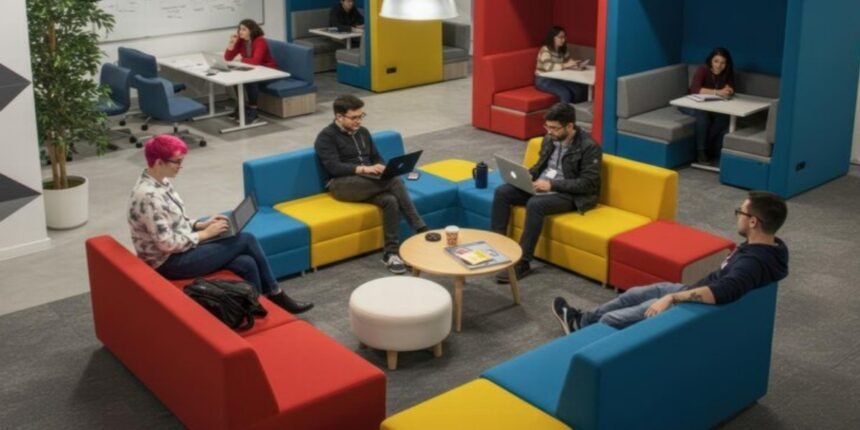Design is more than what meets the eye. The way a workspace or customer-facing area is organized affects comfort, efficiency, and even brand perception. When design functions well, people work better, customers feel more at ease, and operations run smoothly.
Today’s businesses recognize that thoughtful design is a strategic advantage. It goes beyond colors and furniture to address lighting, layout, and the overall user experience. Spaces that blend comfort with efficiency create environments where people want to spend time and perform at their best.
This article explores how design choices influence comfort, productivity, and customer satisfaction, while also improving long-term return on investment.
The Value of Thoughtful Design in the Modern Workplace
Modern offices and public facilities have evolved from static, utilitarian spaces into environments centered on human experience. The focus is now on designing for flexibility, comfort, and well-being.
An office that prioritizes comfort fosters better collaboration and concentration. For customer areas, intuitive layouts and calm aesthetics help people feel welcome and cared for. Design that anticipates user needs not only enhances the experience but also communicates that a business values those who spend time in its space.
Thoughtful design allows businesses to balance productivity and satisfaction, creating workplaces that are efficient yet inviting.
Comfort as a Business Investment
Comfort may seem intangible, but it has measurable effects on performance and customer perception. A comfortable workspace reduces stress and fatigue, enabling employees to focus for longer periods. Natural light, ergonomic furniture, and good acoustics make everyday work easier and more enjoyable.
In customer-facing spaces, comfort drives satisfaction and loyalty. People naturally associate well-designed, pleasant environments with professionalism and trust. A waiting area with good lighting and clear organization, for example, leaves a far better impression than one that feels cramped or neglected.
Comfort translates directly to business results. Employees in well-designed environments show higher engagement, while customers in comfortable surroundings are more likely to return.
Layout and Flow: Making Spaces Work Efficiently
The layout of a space influences how people move and interact within it. An effective design balances collaboration, privacy, and accessibility. Open layouts support communication, while quiet zones and private areas help employees focus when needed.
For customers, clear pathways and visual cues make navigation effortless. Logical layouts minimize confusion, enhance safety, and reduce crowding in high-traffic areas.
Efficient spatial organization improves workflow, reduces wasted time, and enhances comfort for everyone using the facility. When employees and customers can move easily and confidently, the space feels more productive and welcoming.
Material and Finish Choices That Enhance Comfort and Longevity
Materials have a direct impact on how a space feels and performs over time. Softer textures and neutral tones promote calm, while durable finishes simplify maintenance. Selecting the right materials ensures longevity and reduces long-term costs.
For instance, restrooms require materials that are durable and easy to clean, preserving both their appearance and hygiene. High-quality office restroom partitions offer privacy and durability while harmonizing with the overall office design. These selections contribute to cohesive, efficient spaces that are both functional and welcoming.
Material selection is both a design and operational decision. Choosing surfaces that balance comfort, resilience, and ease of care helps spaces remain attractive and practical for years.
The Role of Light, Air, and Sound in Well-Being
Environmental factors shape how people experience a space. Light, air, and sound all influence comfort, mood, and productivity.
Natural light improves energy levels and supports mental health, while adjustable lighting allows employees to adapt to their tasks. Proper ventilation ensures a steady flow of fresh air, which enhances focus and prevents fatigue. Managing sound levels through acoustic panels or layout adjustments reduces distractions and supports concentration.
When these environmental elements are well controlled, the space becomes more comfortable, healthier, and more conducive to productive work.
Designing for Flexibility and Adaptability
Businesses evolve, and their spaces should evolve with them. Flexible design allows rooms and furniture to serve multiple functions as needs change. Movable partitions, modular seating, and adjustable layouts make it easier to reconfigure areas without costly renovations.
Adaptable design ensures longevity by keeping spaces relevant over time. It also allows teams to respond quickly to growth, shifting workflows, or changes in customer behavior. Flexibility reduces long-term expenses while maintaining a fresh, functional environment.
Balancing Aesthetics and Practicality
A successful design strikes a balance between beauty and function. While an attractive space draws attention, practicality determines how well it performs on a day-to-day basis. Finishes that resist wear, easy-to-clean materials, and ergonomic furnishings maintain both appearance and usability.
Aesthetic harmony also matters. Colors and textures that complement one another create calm, unified environments that feel organized and intentional. When visual appeal meets durability, businesses achieve lasting value from their design investments.
Integrating Technology for Efficiency and Comfort
Technology enhances comfort and operational efficiency in modern facilities. Smart lighting systems adjust brightness automatically, while climate controls maintain optimal temperature throughout the day.
Touchless fixtures and automated systems reduce contact points, improving hygiene and user convenience. Scheduling tools, digital signage, and workspace management systems help streamline daily operations.
Integrating technology thoughtfully ensures that comfort is maintained without adding complexity. A well-designed space uses technology to serve people, not the other way around.
Creating a Cohesive Experience Across All Touchpoints
Every area of a business contributes to the overall impression it leaves. Consistency across design elements reinforces brand identity and helps people navigate intuitively.
Cohesive colors, materials, and finishes create a sense of continuity from the reception area to the conference rooms and restrooms. This alignment builds familiarity and trust. When every part of a facility feels intentionally designed, customers and employees alike feel more comfortable and confident in the environment.
Conclusion
Thoughtful design creates comfortable, efficient spaces that boost productivity, welcome employees, and value customers. Investing in design elements such as lighting, layout, and materials offers lasting value through increased productivity, cost savings, morale, and loyalty. A well-designed space reflects company values, enhances performance, and fosters well-being and success.







